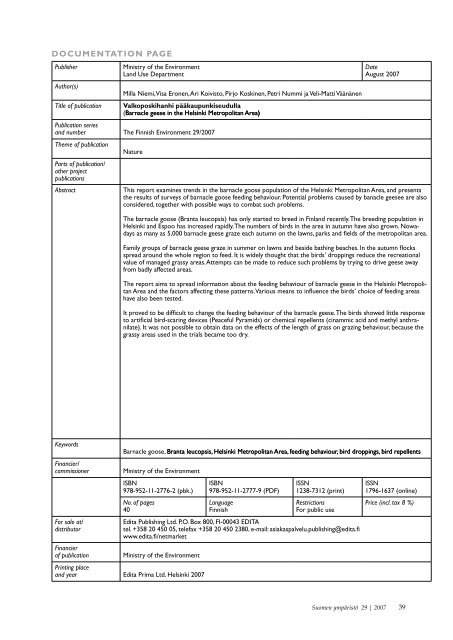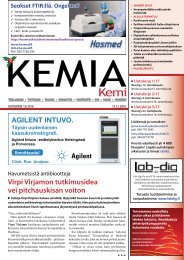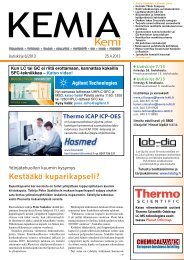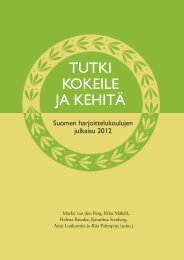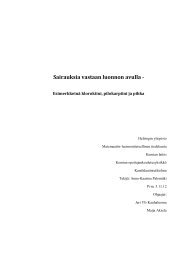1lBorey
1lBorey
1lBorey
Create successful ePaper yourself
Turn your PDF publications into a flip-book with our unique Google optimized e-Paper software.
DOCUMENTATION PAGE<br />
Publisher<br />
Author(s)<br />
Title of publication<br />
Ministry of the Environment<br />
Land Use Department<br />
Milla Niemi, Visa Eronen, Ari Koivisto, Pirjo Koskinen, Petri Nummi ja Veli-Matti Väänänen<br />
Valkoposkihanhi pääkaupunkiseudulla<br />
(Barnacle geese in the Helsinki Metropolitan Area)<br />
Publication series<br />
and number The Finnish Environment 29/2007<br />
Theme of publication<br />
Parts of publication/<br />
other project<br />
publications<br />
Abstract<br />
Nature<br />
Date<br />
August 2007<br />
This report examines trends in the barnacle goose population of the Helsinki Metropolitan Area, and presents<br />
the results of surveys of barnacle goose feeding behaviour. Potential problems caused by banacle geesee are also<br />
considered, together with possible ways to combat such problems.<br />
The barnacle goose (Branta leucopsis) has only started to breed in Finland recently. The breeding population in<br />
Helsinki and Espoo has increased rapidly. The numbers of birds in the area in autumn have also grown. Nowadays<br />
as many as 5,000 barnacle geese graze each autumn on the lawns, parks and fields of the metropolitan area.<br />
Family groups of barnacle geese graze in summer on lawns and beside bathing beaches. In the autumn flocks<br />
spread around the whole region to feed. It is widely thought that the birds’ droppings reduce the recreational<br />
value of managed grassy areas. Attempts can be made to reduce such problems by trying to drive geese away<br />
from badly affected areas.<br />
The report aims to spread information about the feeding behaviour of barnacle geese in the Helsinki Metropolitan<br />
Area and the factors affecting these patterns. Various means to influence the birds’ choice of feeding areas<br />
have also been tested.<br />
It proved to be difficult to change the feeding behaviour of the barnacle geese. The birds showed little response<br />
to artificial bird-scaring devices (Peaceful Pyramids) or chemical repellents (cinammic acid and methyl anthranilate).<br />
It was not possible to obtain data on the effects of the length of grass on grazing behaviour, because the<br />
grassy areas used in the trials became too dry.<br />
Keywords<br />
Financier/<br />
commissioner<br />
For sale at/<br />
distributor<br />
Financier<br />
of publication<br />
Barnacle goose, Branta leucopsis, Helsinki Metropolitan Area, feeding behaviour, bird droppings, bird repellents<br />
Ministry of the Environment<br />
ISBN<br />
978-952-11-2776-2 (pbk.)<br />
No. of pages<br />
40<br />
ISBN<br />
978-952-11-2777-9 (PDF)<br />
Language<br />
Finnish<br />
ISSN<br />
1238-7312 (print)<br />
Restrictions<br />
For public use<br />
Edita Publishing Ltd. P.O. Box 800, FI-00043 EDITA<br />
tel. +358 20 450 05, telefax +358 20 450 2380, e-mail: asiakaspalvelu.publishing@edita.fi<br />
www.edita.fi/netmarket<br />
Ministry of the Environment<br />
Printing place<br />
and year Edita Prima Ltd. Helsinki 2007<br />
ISSN<br />
1796-1637 (online)<br />
Price (incl. tax 8 %)<br />
Suomen ympäristö 29 | 2007<br />
39


